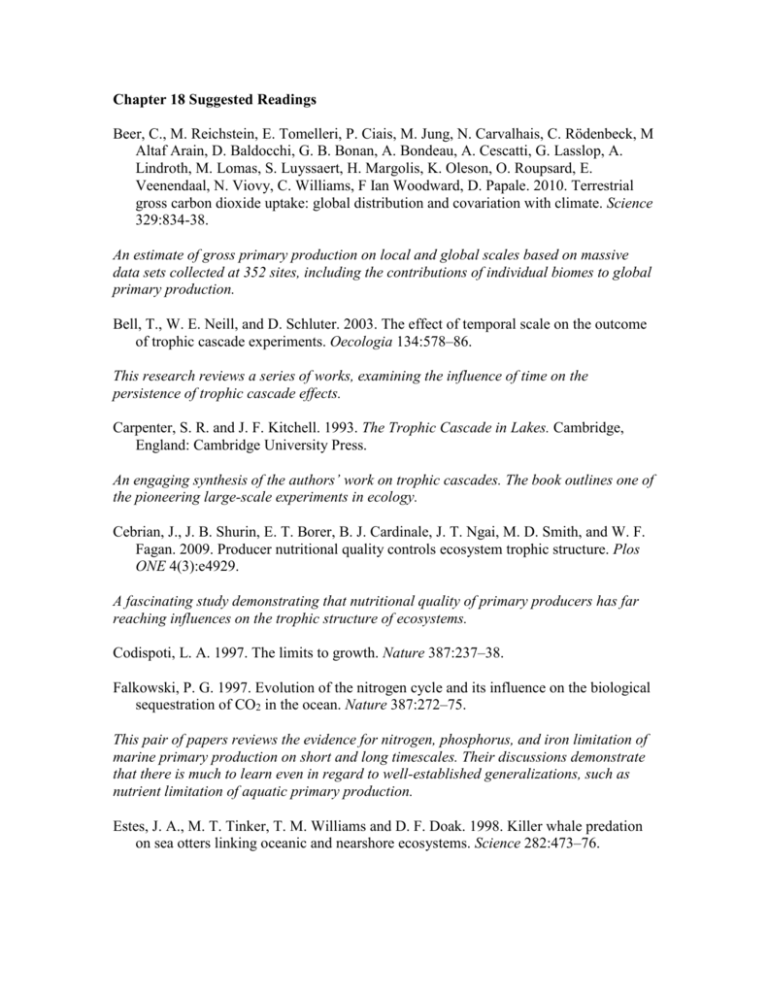Chapter 4 Suggested Readings
advertisement

Chapter 18 Suggested Readings Beer, C., M. Reichstein, E. Tomelleri, P. Ciais, M. Jung, N. Carvalhais, C. Rödenbeck, M Altaf Arain, D. Baldocchi, G. B. Bonan, A. Bondeau, A. Cescatti, G. Lasslop, A. Lindroth, M. Lomas, S. Luyssaert, H. Margolis, K. Oleson, O. Roupsard, E. Veenendaal, N. Viovy, C. Williams, F Ian Woodward, D. Papale. 2010. Terrestrial gross carbon dioxide uptake: global distribution and covariation with climate. Science 329:834-38. An estimate of gross primary production on local and global scales based on massive data sets collected at 352 sites, including the contributions of individual biomes to global primary production. Bell, T., W. E. Neill, and D. Schluter. 2003. The effect of temporal scale on the outcome of trophic cascade experiments. Oecologia 134:578–86. This research reviews a series of works, examining the influence of time on the persistence of trophic cascade effects. Carpenter, S. R. and J. F. Kitchell. 1993. The Trophic Cascade in Lakes. Cambridge, England: Cambridge University Press. An engaging synthesis of the authors’ work on trophic cascades. The book outlines one of the pioneering large-scale experiments in ecology. Cebrian, J., J. B. Shurin, E. T. Borer, B. J. Cardinale, J. T. Ngai, M. D. Smith, and W. F. Fagan. 2009. Producer nutritional quality controls ecosystem trophic structure. Plos ONE 4(3):e4929. A fascinating study demonstrating that nutritional quality of primary producers has far reaching influences on the trophic structure of ecosystems. Codispoti, L. A. 1997. The limits to growth. Nature 387:237–38. Falkowski, P. G. 1997. Evolution of the nitrogen cycle and its influence on the biological sequestration of CO2 in the ocean. Nature 387:272–75. This pair of papers reviews the evidence for nitrogen, phosphorus, and iron limitation of marine primary production on short and long timescales. Their discussions demonstrate that there is much to learn even in regard to well-established generalizations, such as nutrient limitation of aquatic primary production. Estes, J. A., M. T. Tinker, T. M. Williams and D. F. Doak. 1998. Killer whale predation on sea otters linking oceanic and nearshore ecosystems. Science 282:473–76. One of the classic studies of trophic cascades; Estes and his colleagues show how a few killer whales shifting their diet has resulted in the collapse of sea otter populations in western Alaska. Hebblewhite, M., C. A. White, C. G. Nietvelt, M. A. McKenzie, T. E. Hurd, J. M. Fryxell, S. E. Bayley, and P. C. Paquet. 2005. Human activity mediates a trophic cascade caused by wolves. Ecology 86:2135–44. One of the clearest and most thorough demonstrations of a terrestrial trophic cascade. The researchers clearly delineate the direct and indirect interactions in the cascade. Jones, J. I. and C. A. Sayer. 2003. Does the fish-invertebrate-periphyton cascade precipitate plant loss in shallow lakes? Ecology 84:2155–67. An intriguing paper that reports on a trophic cascade in the littoral zone of lakes, involving invertebrate-feeding fish, invertebrates, periphyton, and littoral zone plants. Meserve, P. L., D. A. Kelt, W. B. Milstead, and J. R. Gutiérrez. 2003. Thirteen years of shifting top-down and bottom-up control. BioScience 53:633–46. This long-term study of a terrestrial ecosystem in Chile documents a shifting influence of top-down and bottom-up control of community structure that depends on large-scale climate dynamics. Polis, G. A., A. L. W. Sears, G. R. Huxel, D. R. Strong, and J. Maron. 2000. When is a trophic cascade a trophic cascade? Trends in Ecology & Evolution 15:473–75. This is a thought-provoking call for consistency in the way ecologists use the term “trophic cascade.” Ripple, W. J. and R. L. Beschta. 2004. Wolves and the ecology of fear: can predation risk structure ecosystems? BioScience 54:755–66. Ripple, W. J. and R. L. Beschta. 2007 Restoring Yellowstone’s aspen with wolves. Biological Conservation 138:514–19. Two key papers concerning the unfolding evidence for a wolf-elk-aspen trophic cascade in Yellowstone National Park. Schmitz, O. J., P. A. Hamback, and A. P. Beckerman. 2000. Trophic cascades in terrestrial systems: a review of the effects of carnivore removals on plants. American Naturalist 155:141–53. A review that supports the applicability of the trophic cascade hypothesis to terrestrial as well as aquatic systems. Sinclair, A. R. E., S. Mduma, and J. S. Brashares. 2003. Patterns of predation in a diverse predator-prey system. Nature 425:288–90. Terborgh, J., K. Feeley, M. Silman, P. Nuñez, and B. Balukjian. 2006. Vegetation dynamics of predator-free land-bridge islands. Journal of Ecology 94:253–63. These two studies take advantage of exceptional situations to investigate the potential for trophic cascades in two tropical ecosystems. The first shows the potential for a trophic cascade on the Serengeti by demonstrating that predators control the abundance of several species of mammalian herbivores, while the second documents a trophic cascade in a South American tropical forest. Thomey, M. L., S. L. Collins, R. Vargas, J. E. Johnson, R. F. Brown, D. O. Natvig, and M. T. Friggens. 2011. Effect of precipitation variability on net primary production and soil respiration in a Chihuahuan Desert grassland. Global Change Biology 17:1505-15. The research team shows that in arid systems variability in precipitation may be more important than total precipitation, that is, a few large precipitation events provides more of a stimulus to primary production than many small events. Trussell, G. C., P. J. Ewanchuk, and C. M. Matassa. 2006. The fear of being eaten reduces energy transfer in a simple food chain. Ecology 87:2979–84. Intriguing demonstration of how fear of predation reduces ecological efficiency in an intertidal community.







